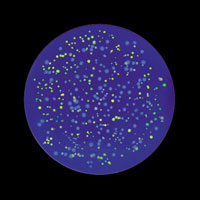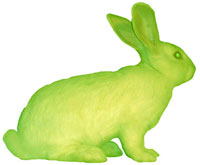WHAT LORI HAS TO SAY ABOUT EDUARDO'S WORK
 Eduardo Kac, a professor at the School of the Art Institute, is the person who first introduced me to genetic art. We were at lunch and he handed me a piece of paper containing a single sentence: "Let man have dominion over the fish of the sea, and over the fowl of the air, and over every living thing that moves upon the earth."
Eduardo Kac, a professor at the School of the Art Institute, is the person who first introduced me to genetic art. We were at lunch and he handed me a piece of paper containing a single sentence: "Let man have dominion over the fish of the sea, and over the fowl of the air, and over every living thing that moves upon the earth."
I recognized it, from Genesis in the Bible.
He showed me another page, in which he had translated the sentence into Morse code.
So? I thought. This is just the sort of thing I did in fourth grade with my codes and ciphers books.
Then I flipped to the third page and it became clear what Eduardo was doing. That page has a sequence of letters that begins: CTCCGCGTA....
Eduardo had translated the Biblical Genesis into the genetic code. He needed to go from the 26-letter English alphabet to the four-letter alphabet of the genetic code, which contains only G, A, T, and C (the chemical bases guanine, adenine, thymine, and cytosine, which are the building blocks of life). The intermediate step, the Morse Code, allowed him to use the following conversion principle: the dot in Morse Code becomes a C; the line, a T; the word space, an A; the letter space, a G. He created the formula for a gene out of a sentence in the Bible. He then gave the gene sequence to Buck Strom, then Director of Medical Genetics and the DNA Laboratory at Illinois Masonic Hospital, who began ordering parts from Clonetech, a biotech company. They made the gene and put it in a gallery.
 But then Eduardo went one step further. He set it up so that anyone, anywhere, could hook up to the exhibit over the Internet, and, with a click of their mouse, could cause an ultraviolet light to go on over the petri dish, causing the gene to mutate. With just one work of art, Eduardo turned everyone into a biotechnologist.
But then Eduardo went one step further. He set it up so that anyone, anywhere, could hook up to the exhibit over the Internet, and, with a click of their mouse, could cause an ultraviolet light to go on over the petri dish, causing the gene to mutate. With just one work of art, Eduardo turned everyone into a biotechnologist.
In his next major work, Eduardo—with the aid of a scientist—put the gene that causes a jellyfish to fluoresce into a rabbit embryo, creating a bunny, Alba, that glows green under certain light.
The technique that the scientists used to create Alba could very well be used on people. Researchers in Atlanta removed a gene from a prairie vole, an affectionate, monogamous rodent that spends half its time cuddling. They transferred the gene to a closely related species, the mountain vole, which lives a promiscuous lifestyle. The recipient rodents did not become monogamous, but their brains developed to look like those of prairie voles and they became more cuddly and affectionate.
 I began to speculate on the potential applications to humans. In the wedding of the future, would we not only promise to love, honor, cherish, and obey—but also to have a prairie vole gene implant?
I began to speculate on the potential applications to humans. In the wedding of the future, would we not only promise to love, honor, cherish, and obey—but also to have a prairie vole gene implant?
Viewing one of Eduardo's exhibits, art critic Arlindo Machado of the University of Sao Paulo wondered whether, in the future, our inherited genes would mean less than our artificial additions. "Will we still be black, white, mulatto, Indian, Brazilian, Polish, Jewish, female, male, or will we buy some of these traces at a shopping mall?" he asks. "In this case, will it make sense to speak of family, race, nationality? Will we have a past, a history, an 'identity' to be preserved?"

Genesis is a synthetic gene that was created by Kac by translating a sentence from the biblical book of Genesis into Morse Code, and converting the Morse Code into DNA base pairs according to a conversion principle specially developed by the artist for this work.
See what Eduardo has to say about his work.
See lots of cool stuff by other genetic artists.
Jellyfish Photo: David Wrobel
All content © 2006-07 by Lori Andrews.
loriandrews.com